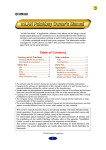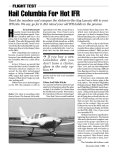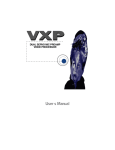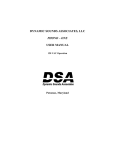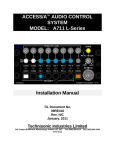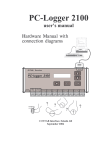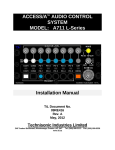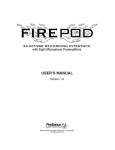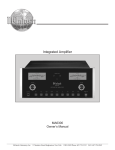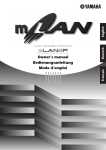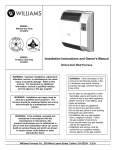Download FIREstation Owner`s Manual
Transcript
FIREstation FireWire™ Recording Interface User's Manual VERSION 2.0 PreSonus Audio Electronics Presonus Limited Warranty Presonus Audio Electronics Inc. warrants this product to be free of defects in material and workmanship for a period of one year from the date of original retail purchase. This warranty is enforceable only by the original retail purchaser. To be protected by this warranty, the purchaser must complete and return the enclosed warranty card within 14 days of purchase. During the warranty period Presonus shall, at its sole and absolute option, either repair or replace, free of charge, any product that proves to be defective on inspection by Presonus or its authorized service representative. To obtain warranty service, the purchaser must first call or write Presonus at the address and telephone number printed below to obtain a Return Authorization Number and instructions of where to return the unit for service. All inquiries must be accompanied by a description of the problem. All authorized returns must be sent to the Presonus repair facility postage prepaid, insured and properly package. Proof of purchase must be presented in the form of a bill of sale, canceled check or some other positive proof that the product is in within the warranty period. Presonus reserves the right to update any unit returned for repair. Presonus reserves the right to change or improve design of the product at any time without prior notice. This warranty does not cover claims for damage due to abuse, neglect, alteration or attempted repair by unauthorized personnel, and is limited to failures arising during normal use that are due to defects in material or workmanship in the product. Any implied warranties, including implied warranties of merchantability and fitness for a particular purpose, are limited in duration to the length of this limited warranty. Some states do not allow limitations on how long an implied warranty lasts, so the above limitation may not apply to you. In no event will Presonus be liable for incidental, consequential or other damages resulting from the broach of any express or implied warranty, including, among other things, damage to property, damage based on inconvenience or on loss of use of the product, and, to the extent permitted by law, damages for personal injury. Some states do not allow the exclusion of limitation of incidental or consequential damages, so the above limitation or exclusion may not apply to you. This warranty gives you specific legal rights, and you may also have other rights, which vary form state to state. This warranty only applies to products sold and used in the United States of America. For warranty information in all other countries please refer to your local distributor. Presonus Audio Electronics, Inc. 7257 Florida Blvd. Baton Rouge, LA 70806 225-216-7887 www.presonus.com i Limited Warranty Outside of The U.S. Presonus Audio Electronics products are warranted only in the country where purchased, through the authorized Presonus distributor in that country, against defects in material and workmanship. The specific period of this limited warranty shall be that which is described to the original retail purchaser by the authorized Presonus dealer or distributor at the time of purchase. Presonus does not, however, warrant its products against any and all defects: 1) arising Out of materials or workmanship not provided or furnished by Presonus, or 2) resulting from abnormal use of the product or use in violation of instructions, or 3) in products repaired or serviced by other than authorized Presonus repair facilities, or 4) in products with removed or defaced serial numbers, or 5) in components or parts or products expressly warranted by another manufacturer. Presonus agrees, through the applicable authorized distributor, to repair or replace defects covered by this limited warranty with parts or products of original or improved design, at its option in each respect, if the defective product is shipped prior to the end of the warranty period to the designated authorized Presonus warranty repair facility in the country where purchased, or to the Presonus factory in the U.S., in the original packaging or a replacement supplied by Presonus, with all transportation cost and full insurance paid each way by the purchaser or owner. All remedies and the measure of damages are limited to the above services. It is possible that economic loss or injury to person or property may result from the failure of the product; however, even if Presonus has been advised of this possibility, this limited warranty does not cover any such consequential or incidental damages. Some states or countries do not allow the limitations or exclusion of incidental or consequential damages, so the above limitation may not apply to you. Any and all warranties, express or implied, arising by law, course of dealing, course of performance, usage of trade, or otherwise, including but not limited to implied warranties of merchantability and fitness for a particular purpose, are limited to a period of two years from either the date of original retail purchase or, in the event no proof of purchase date is available, the date of manufacture. Some states or countries do not allow limitations on how long an implied warranty last, so the above limitations may not apply to you. This limited warranty gives you specific legal rights, and you may also have other rights, which vary from state to state, country to country. Presonus Audio Electronics, Inc. 7257 Florida Blvd. Baton Rouge, LA 70806 225-216-7887 www.presonus.com ii Table of Contents 1.1 Introduction.....................................................................1 1.2 Notes on Computer-Based Recording........................................................... 1 2.1 Basic Setup & Applications................................................2 2.2 Computer Setup........................................................................................... 2 2.3 Recording..................................................................................................... 3 2.4 Mixing........................................................................................................... 3 2.5 Internal Mix Mode ........................................................................................ 4 2.6 External Mix Mode........................................................................................ 5 2.7 Stand-Alone Mode (Special ADAT Mode)...................................................... 6 2.8 Stand-Alone Mode (With DigiDesign 001™) ................................................. 7 2.9 ADAT Mode................................................................................................... 8 3.1 Features...........................................................................9 3.2 Switchable Preamps..................................................................................... 9 3.3 Zero-Latency Line-Mixer............................................................................... 9 3.4 Volume Control............................................................................................. 9 3.5 Clock Control................................................................................................ 9 3.6 mLAN/FireWire........................................................................................... 1 0 3.7 Footswitch Input......................................................................................... 1 0 3.8 MIDI 1 0 3.9 ADAT.......................................................................................................... 1 0 3.10 S/PDIF........................................................................................................ 1 1 3.11 B N C 1 1 4.1 Front Panel ....................................................................12 4.2 Preamps..................................................................................................... 1 2 4.3 Inputs......................................................................................................... 1 2 4.4 Meters........................................................................................................ 1 3 4.5 + 4 8 V.......................................................................................................... 1 3 iii 4.6 Pad 1 3 4.7 Zero-Latency Line Mixer............................................................................. 1 4 4.8 Channels One-Eight.................................................................................... 1 4 4.9 MLAN Return .............................................................................................. 1 5 4.10 Master Control............................................................................................ 1 6 4.11 Headphone/Main Out Control..................................................................... 1 7 4.12 Mixer.......................................................................................................... 1 7 4.15 S/PDIF........................................................................................................ 1 8 4.16 ADAT.......................................................................................................... 18 4.17 ADAT To mLAN........................................................................................... 1 8 4.18 S/PDIF To mLAN......................................................................................... 1 8 4.19 Clock .......................................................................................................... 1 9 4.20 External Control (Slave Mode) ................................................................... 1 9 4.21 B N C 1 9 4.22 m L A N ......................................................................................................... 1 9 4.23 ADAT.......................................................................................................... 2 0 4.24 INT 2 0 4.25 Buttonology Notes...................................................................................... 2 0 5.1 Back Panel.....................................................................21 5.2 IEC Power Connector.................................................................................. 2 1 5.3 Power On/Off.............................................................................................. 2 1 5.4 FireWire/IEEE 1394 I/O.............................................................................. 21 5.5 MIDI And S/PDIF Port ................................................................................ 2 2 5.6 MIDI Daisy-Chain Example......................................................................... 2 3 5.7 ADAT.......................................................................................................... 2 3 5.8 B N C 2 3 5.9 Footswitch Input......................................................................................... 2 4 5.10 TRS Line Ins/Outs ...................................................................................... 2 4 5.11 TRS Preamp Sends..................................................................................... 2 5 5.12 Main Out..................................................................................................... 2 5 iv 6.1 Top Panel.......................................................................26 6.2 Analog To Digital Converter Line Level Adjust............................................ 2 6 6.3 Heat Vent................................................................................................... 2 6 7.1 Software........................................................................27 7.2 Operating System ...................................................................................... 2 7 7.3 Recording Software.................................................................................... 2 7 8.1 Troubleshooting.............................................................28 8.2 The ADAT Input/Output Doesn’t Support Optical S/PDIF ........................... 2 8 8.3 Pops, Clicks, And/Or Distortion Are Present In The Audio Signal ............... 2 8 8.4 ADAT I/O Cannot Be Used In Conjunction With The Line Or S/PDIF I/O.... 2 8 8.5 The Preamps Noise Floor Is Higher When The Tube Drive Is Engaged....... 2 9 8.6 mLAN Returns Three And Four Do Not Work In ADAT Mode ...................... 2 9 8.7 Word Clock Synchronization (Sync) ........................................................... 2 9 8.8 MIDI ........................................................................................................... 3 0 8.9 Footswitch.................................................................................................. 3 0 8.10 Latency....................................................................................................... 3 0 8.11 Drivers ....................................................................................................... 3 1 8.12 Operating Systems..................................................................................... 3 1 8.13 N o n-Presonus FireWire/mLAN Devices....................................................... 3 1 8.14 Line-Mixer Doesn’t Work When Using FIREstation As Stand-Alone A-D ..... 3 2 8.15 The EXT Button Is Blinking......................................................................... 3 2 8.16 The Sample Rate LED Is Blinking ............................................................... 3 2 8.17 S/PDIF Feedback Loop ............................................................................... 3 2 9.1 Technical Specifications..................................................33 v 1.1 INTRODUCTION Thank your for purchasing the Presonus FIREstation. We feel that we have created a reliable, versatile and affordable piece of audio equipment. It is designed to meet a multitude of professional digital recording applications. If you have any questions or comments in regards to this or any other piece of Presonus equipment, please feel free to contact us! 1.2 NOTES ON COMPUTER-BASED RECORDING The Presonus FIREstation is a recording interface only. Many problems can arise when converting a standard computer into a DAW (Digital Audio Workstation). Presonus only provides support for issues that directly relate to the FIREstation. It may be necessary to contact the manufacturer of the operating system or software to obtain additional technical support. Presonus does not provide support for issues in regards to operating systems, additional hardware or software. Please check our website, www.presonus.com regularly for software, firmware, and technical support updates. 1 2.1 BASIC SETUP & APPLICATIONS 2.2 Computer Setup Place the provided driver’s software in your computer after powering it up. If an install wizard appears, direct it to the provided CD-ROM when prompted. If the install wizard does not appear, open the CD-ROM and run the Auto Installer from there. Follow the directions on your screen. NOTE: It is essential that the FIREstation not be connected to the computer when the drivers are installed. If you accidentally leave the FIREstation connected, disconnect the unit, uninstall the drivers, reboot and then reinstall the drivers. After the driver fully installs power down your computer. Turn off all external devices before connecting the FIREstation(s). Connect all external devices to the FIREstation(s). Power up the FIREstation and then connect the FIREstation to the computer using the provided 6-pin FireWire cable. Fasten your seatbelt and then power up the computer. Three different items will be loaded on your computer at this point. The first item that is loaded is the actual software driver. The driver allows your computer to recognize and communicate with the FIREstation. A control panel is also loaded. The control panel indicates if the FIREstation is connected properly. It also indicates and helps control sample rate and clock control (sync). A patchbay is also loaded. The patchbay allows the user to route the inputs and outputs of the FIREstation in computer. It is important to note that each FIREstation has a unique Identity. So, if a FIREstation is connected and routed, that routing scheme that is saved will only work for that 2 specific FIREstation. If a different FIREstation is added, it will need to be rerouted. 2.3 Recording When recording the headphone output can be used for headphone monitoring and the main outs can be used for control room monitors. This setup negates the need for an external mixer. The volume setting of the Main/Headphone outs and the Line Mixer do not affect the recording level. 2.4 Mixing As far as the use of the FIREstation goes there are two different mix modes: Internal and External. Each mode has its benefits that are determined by your overall computer speed and capacity, familiarity with recording software, and creativity. 3 2.5 Internal Mix Mode SPEAKER SPEAKER COMPUTER CD RECORDER POWER PreSonus FIRESTATION IN MIDI - S/PDIF (S/PDIF input and output on channels 7/8) FIREWIRE PORTS 1 CLOCK MIC/INSTRUMENT 5 7 1 3 LINE OUTPUTS - TRS BALANCED OUT Created, Designed and Manufactured In The USA 3 5 7 1 L PREAMP SEND - TRS 2 R FOOTSWITCH (Record Punch) ADAT™ optical 2 4 6 8 LINE INPUTS - TRS BALANCED 2 4 6 8 MAIN OUT 115/230 VAC ~ By internal Jumper 30Watts -32 -16 MIC/INSTRUMENT CLIP -32 48V 0 -16 DIRECT PATCH LINE MIXER CLIP 48V 0 293 MIC/LINE IN 1/2 LINE IN 3/4 0 LINE IN 5/6 0 293 MASTER CONTROL SPDIF/LINE IN 7/8 C C 0 0 mLAN RETURN M I X E R SPDIF 0 CLOCK A D A T EXT INT 6 0 A D A T TS O PDIF TO m L A N m L A N PAD PAD B M Cm L A A N D A T PREAMP 1 92 -12 494 +12 GAIN TUBE DRIVE GUITAR PREAMP 2 92 -12 GAIN 494 +12 TUBE DRIVE -80 +10 ONE d B TWO Mono -80 +10 THREE d B L FOUR Mono -80 PAN +10 d B MICROPHONE R LEVEL Stereo L -80 +10 PAN d B R LEVEL Stereo -80 +10 1/2 d B 3/4 0 -80 PHONES +10 d B 12 MAINOUT 32k 4 4 . 1 k 48k Stereo HEADPHONES Internal mode signifies that you are using software and internal plugins to mix a project. In this instance only the master outputs and headphone outputs would be used. The internal mode is preferred in some situations dependent on the environment and other factors. For example, wouldn’t it be nice to mix a song over headphones while sitting in a hotel room between live performances? 4 2.6 External Mix Mode SPEAKER SPEAKER COMPUTER CD RECORDER POWER PreSonus FIRESTATION FIREWIRE PORTS IN MIDI - S/PDIF (S/PDIF input and output on channels 7/8) ADAT™ optical FOOTSWITCH (Record Punch) Created, Designed and Manufactured In The USA 1 CLOCK 3 5 7 1 LINE OUTPUTS - TRS BALANCED OUT 2 4 6 8 3 5 7 LINE INPUTS - TRS BALANCED 2 4 6 8 1 PREAMP SEND - TRS 2 L MAIN OUT R 115/230 VAC ~ By internal Jumper 30Watts GUITAR MICROPHONE MIXER External mode incorporates other equipment beyond the FIREstation. For example, an external mixer and other processors may be used. In this mode, the outputs of the FIREstation could be routed to external equipment for dynamics processing, effects and other forms of manipulation. The master outputs could then be returned to two channels of the FIREstation to record the “Master Mix”. 5 2.7 Stand-Alone Mode (Special ADAT Mode) MASTER CONTROL MIXER SPDIF ADAT 6 0 ADAT TO mLAN 0 -80 PHONES +10 dB SPDIF TO mLAN 12 MAIN OUT The FIREstation can be set in stand-alone mode by pressing the Mixer and ADAT buttons simultaneously. Stand-alone mode allows the FIREstation to do two main things: act as an ADAT line mixer and perform A/D and D/A conversion. The signal plugged into either the ADAT I/O will be routed to the opposite set of analog ports. For example, if a DigiMAX were plugged into the ADAT input, the same signal would be sent to the TRS outputs. The line mixer would also function, allowing the user to monitor all eight channels. ADAT Input Analog Mixer Line Outs ADAT Out NOTE: When using the FIREstation as an Analog to Digital (A-D) converter, the line mixer does not contain the analog inputs, just the ADAT inputs. 6 2.8 Stand-Alone Mode (With DigiDesign 001™) COMPUTER DIGIDESIGN 001™ POWER PreSonus FIRESTATION FIREWIRE PORTS IN MIDI - S/PDIF (S/PDIF input and output on channels 7/8) ADAT™ optical FOOTSWITCH (Record Punch) Created, Designed and Manufactured In The USA 1 CLOCK 3 5 7 1 LINE OUTPUTS - TRS BALANCED OUT 2 4 6 8 3 5 7 LINE INPUTS - TRS BALANCED 2 4 6 8 1 PREAMP SEND - TRS 2 L MAIN OUT R 115/230 VAC ~ By internal Jumper 30Watts NOTE: You would want to be in ADAT special mode for this application. 7 2.9 ADAT Mode MASTER CONTROL MIXER SPDIF ADAT 6 0 ADAT TO mLAN 0 -80 +10 dB PHONES SPDIF TO mLAN 12 MAIN OUT Another stand-alone mode occurs when just the ADAT button is pressed. In this mode, the FIREstation acts as an ADAT line mixer or converter. The ADAT signal can be converted to analog while being routed through the line mixer. It is important to note that the analog inputs are not functional in this mode. Mixer ADAT Input Line Outs ADAT Out Analog Inputs Nowhere 8 3.1 FEATURES The following is a summary of the features of the FIREstation: 3.2 Switchable Preamps The two preamps on the FIREstation can be switched between solidstate and tube driven. The outer knob of the preamp controls gain and the inner knob controls tube drive. The tube drive is completely disengaged when the knob is turned fully counter clockwise until the knob clicks. 3.3 Zero-Latency Line Mixer The FIREstation utilizes an onboard line mixer that eliminates latency (monitoring delay). Every channel of the FIREstation can be routed to the onboard line mixer. The mixer can be functional whether connected to a computer or not. 3.4 Volume Control The dual concentric volume control knob controls the amount of volume to the headphone jack on the inner knob and to the master outputs on the outer knob. 3.5 Clock Control The FIREstation has BNC Word Clock connectors for external (slave) and internal (master) Word Clock sync. A MIDI I/O is provided for additional machine control including MTC, MMC, and MIDI. The ADAT I/O can also provide or carry Word Clock as well. 9 3.6 mLAN/FireWire The FIREstation utilizes the mLAN protocol. This standard allows the unit to be connected to and share information with a multitude of digital devices. mLAN is an advanced network protocol that allows multiple FIREstations and/or other digital devices to be interconnected. Examples of these devices would be: external hard drives, digital camcorders, and synthesizers. 3.7 Footswitch Input The footswitch input on the back of the unit allows the user to start and stop recording at any desired moment. Every different software manufacturer requires a different setup for use of this footswitch receptacle. Please consult your software manufacturers manual, website, or customer support for proper setup of this feature. The FIREstation does not come equipped with a footswitch. (The footswitch must be purchased separately.) 3.8 MIDI MIDI stands for ‘Musical Instrument Digital Interface’. However, the MIDI standard goes well beyond sequencing. The MIDI I/O allows connection or communication with external MIDI equipment. One function of this port is MIDI programming. This port can also be used for MMC (MIDI Machine Control), MTC (MIDI Time Control), and sequencing. 3.9 ADAT The ADAT I/O allows interconnectivity between the FIREstation and devices using ADAT I/O. The fiber-optic input does not support Optical S/PDIF (two channels). The ADAT standard allows up to eight channels 10 of audio, at up to 24-bit 48k resolution, to be transferred simultaneously in one direction. 3.10 S/PDIF The S/PDIF I/O allows the FIREstation to transfer/receive audio from other digital audio devices. 3.11 BNC The BNC I/O is designed to allow the FIREstation to sync frame rates with other digital devices. This sync prevents pops, clicks and distortion. 11 4.1 FRONT PANEL MIC/INSTRUMENT -32 -16 -3 (dBfs) MIC/INSTRUMENT -32 -16 -3 DIRECT PATCH LINE MIXER (dBfs) MIC/LINE IN 1/2 48V 26 10 48V 26 10 LINE IN 3/4 0 LINE IN 5/6 0 MASTER CONTROL SPDIF/LINE IN 7/8 C 0 mLAN RETURN C 0 M I X E R SPDIF 0 CLOCK A D A T 6 0 EXT INT A D A T TS O PDIF TO m L A N m L A N 18 44 18 44 PAD PAD B M Cm L A A N D A T 10 ( C L I C K ) PREAMP 1 T U B E O F F G A I N 20 54 TUBE DRIVE 10 ( C L I C K ) PREAMP 2 T U B E O F F G A I N 20 54 TUBE DRIVE -80 +10 -80 +10 dB ONE Mono dB TWO THREE FOUR Mono L -80 +10 dB PAN Stereo R LEVEL L -80 +10 dB PAN Stereo R LEVEL -80 +10 dB 1/2 3/4 0 -80 PHONES dB +10 12 MAIN OUT 32k 4 4 . 1 k 48k Stereo 4.2 Preamps The two preamps on the FIREstation are switchable. They can be changed between solid-state and tube driven. The tube drive is deactivated when the inner knob of the preamp is turned fully counterclockwise. This stage is indicated by a click when the knob is turned fully counter-clockwise. The inner knob on each channel controls the amount of signal routed to the 12AX7 vacuum tube. This feature lets you control how much saturation of the signal occurs. Greater levels of tube saturation give the signal greater warmth and a richer sound or desirable distortion in extreme cases. This works equally well on mics and instruments. NOTE: Fully engaging the tube drive may increase the noise floor. NOTE: It is recommended that the Control Room and Headphone volumes be turned all the way down when the tube drive is initially turned on. 4.3 Inputs Each preamplifier has a Neutrik combo connector input. The input accepts either XLR or 1/4” instrument inputs. The 1/4” or Hi-Z input is designed for use with a guitar, bass, etc. This input is not a line level input. 12 4.4 Meters The input meters above the preamps indicate signal strength. Turning the preamps gain control too far clockwise could cause the preamp to clip. The clip indicator light will be illuminated at this point. In order to overdrive the input while still maintaining a useable recording level a compressor/limiter is needed. Several high quality compressors/limiters are available from Presonus. Some examples of these products are the BlueMAX, ACP22, ACP88, and CL44. Please refer to www.presonus.com for more details on these fine products. 4.5 +48V Each preamp has a +48 volt phantom power switch. Phantom power is required for some microphones. These microphones are referred to as electrostatic or condenser. These microphones require an external power source in order to operate. 4.6 Pad A –20 dB pad is provided on each preamp. The pad drops the signal by –20dB to accommodate higher level (louder) signals. The pad is especially useful when using microphones that require phantom power. NOTE: Often times phantom powered microphones produce a higher level (louder) output, which is why the pad is useful when using these (phantom/condenser) microphones. 13 4.7 Zero-Latency Line Mixer DIRECT PATCH LINE MIXER MIC/LINE IN 1/2 LINE IN 3/4 0 -80 +10 -80 dB ONE LINE IN 5/6 0 +10 dB TWO Mono THREE FOUR Mono SPDIF/LINE IN 7/8 C 0 L -80 +10 dB PAN mLAN RETURN C 0 R LEVEL Stereo L -80 0 +10 dB PAN R LEVEL -80 +10 dB 1/2 Stereo 3/4 Stereo All 12 channels of the line mixer are routed directly to the Headphone/Main Output volume control knobs/outputs. Every two/four (according to the signal designation) channels are grouped together sequentially to one dual concentric knob. 4.8 Channels One-Eight The first two knobs allow for independent channel volume control without panning (one and two, three and four). The amount of volume given to each channel dictates the amount of volume to the headphone/main out. The second two knobs group the channels in stereo pairs (five and six, seven and eight). The inner part of the knob controls the amount of signal (volume) that goes to the headphone/main control and the outer ring controls panning. Each pair of channels is routed directly to the headphone/main outputs. Therefore, the FIREstation can be used as a line mixer without connection to a computer. There is no latency or delay between the time the signal hits the respective input and goes to the headphone/main output. This routing scenario ensures that what is heard through the headphone/main output is occurring at exactly that moment. 14 4.9 mLAN Return The last knob of the FIREstation line mixer is dedicated to channels assigned to the unit by the computer. These channels are the channels routed to outputs one-four (TRS line out) on the FIREstation. These knobs differ from the others in that there is no pan assignment. The outer ring controls the line mixer volume of returning channels one and two and the inner ring controls the returning channels volume of three and four. The computer dictates panning on this dual concentric knob. If channels are not routed to the FIREstation by the computer, they will not be able to be monitored by the line mixer from either output. NOTE: The speed of the computer will determine the amount of signal delay (latency) to these inputs. If a significant amount of delay is noticed, the computer or software manufacturer may need to be consulted to improve performance. When the S/PDIF input is selected, it is automatically routed to channels seven and eight. It is not possible to route this pair of inputs to any other input channels. This is similar to when the ADAT input is engaged. When the ADAT input is selected, it occupies channels one through eight. The analog and S/PDIF inputs are not useable at this point. This feature is especially useful when using the DigiMAX or DigiMAX LT (microphone preamplifiers manufactured by Presonus) on the ADAT input. This feature eliminates the need for external mixing equipment. The last channels on the line mixer are reserved for two to four channels returning from the computer. These channels allow you to 15 monitor what you have already recorded in conjunction with what is currently being recorded. The signals sent to these four channels are set on the computer itself. These channels are the physical channels that are returned to the FIREstation from the computer. These returns would be FIREstation outputs one-four. It is also important to note that when in ADAT/Stand Alone mode that mLAN returns three and four are not active. NOTE: These two pairs (FIREstation outputs one-four) of channels cannot be reassigned using the FIREstation itself. Any channel redistribution must be configured using the host software or operating system. 4.10 Master Control MASTER CONTROL MIXER SPDIF ADAT 6 0 ADAT TO mLAN 0 -80 PHONES +10 dB SPDIF TO mLAN 12 MAIN OUT The DIGITAL section of the faceplate of the FIREstation refers to clock control. Clock control is necessary to provide stability in recording digital material. Word Clock is the common protocol used for synching digital audio recording devices. Word Clock ensures that different devices maintain the same recording frame rate. This frame rate protocol prevents digital dropout, clicks, pops, and distortion. The FIREstation has two different clock modes, INT (internal) and EXT (external). The internal option allows the FIREstation to stand alone or be the master. When using the INT mode, other digital devices could 16 be synched to the FIREstation by either using the BNC Word Clock output, the ADAT output, or the FireWire output. The EXT mLAN mode causes the unit to be synched to the computer. This mode is especially useful when recording with multiple FIREstations. The other EXT modes would sync the FIREstation to other digital devices either by the BNC in, or the ADAT in. NOTE: S/PDIF external sync is not necessary because the (S/PDIF) input signal is resampled and realigned by the FIREstation. 4.11 Headphone/Main Out Control The headphone/main out control respectively controls the two outputs independently. The inner ring controls the HEADPHONE volume and the outer knob controls the MAIN OUT volume. The audio content of both volume controls is dependent on the routing and volume settings of the line mixer. It is strongly recommended that the volume of both of these outputs be lowered completely when engaging the tube drive, connecting or disconnecting external equipment or when powering up the unit. NOTE: If a signal is not routed to the line mixer, it will not be present in either headphone/main out signal output. 4.12 Mixer The MIXER button engages the line mixer. If this button is not engaged, only mLAN return channels one and two will be present in the Headphone/Main out mix. All other functions of the mixer will be disabled. 17 NOTE: if the mixer button is not engaged, the computer sets the volume of mLAN returns one and two. In other words, the mLAN return knob (potentiometer) is inactive (non-functional). 4.13 S/PDIF The S/PDIF button switches channels seven and eight so that they accept the S/PDIF input rather than the 1/4” TRS in or ADAT In. This button assigns the S/PDIF inputs to channels seven and eight of the line mixer. 4.14 ADAT The ADAT button assigns the ADAT input signal to the line mixer and to the TRS outputs as well. This button essentially defeats the TRS inputs to the mixer and mirrors the ADAT input on the TRS outputs. The ADAT button has other uses as well. Please refer to the Basic Setup And Applications section of this manual for further details. 4.15 ADAT To mLAN The ADAT to mLAN button routes the ADAT input to the mLAN output going to the computer. 4.16 S/PDIF To mLAN The S/PDIF to mLAN button activates the S/PDIF input. This button routes the S/PDIF input to the computer, replacing channels seven and eight. The S/PDIF button has other uses as well. Please refer to the APPLICATIONS section of this manual for further details. 18 4.17 Clock CLOCK EXT BMC 32k INT mLAN ADAT 44.1k 48k 4.18 External Control (Slave Mode) When the FIREstation is set to EXT, Word Clock is determined or set by an external device. The three external controllers are BNC, mLAN, and ADAT. 4.19 BNC The FIREstation can be synced to another digital device by using the BNC input. The BNC output could also be used to control other devices by Word Clock. For example the DigiMAX and DigiMAX LT (preamps made by Presonus) use BNC outputs to send Word Clock to other devices for sample accurate recording. 4.20 mLAN mLAN would be the most common clock mode for the FIREstation. This allows the computer to be the master clock. Word Clock is then transferred to external devices via FireWire or BNC. The sampling rate would be set in the mLAN control panel. Currently, mLAN protocol uses two sampling rates: 44.1kHz and 48kHz. NOTE: All other clock modes allow the use of the 32kHz sampling rate, even though mLAN does not. 19 4.21 ADAT ADAT mode would slave the FIREstation(s) to an external device that utilized an ADAT optical output. The unit would automatically sync itself to the sampling rate of the external device. The ADAT mode would most likely be used when a BNC output is not present on the external device. 4.22 INT Three different sample rates are available. These rates are 32k, 44.1k, and 48k. The higher the resolution, the more hard drive space required. For example, one minute of stereo recording at 44.1kHz requires 10 MB of hard drive space per minute. NOTE: The FIREstation always records at a 24-bit resolution. In order to record at a lower resolution, the software has to be set to dither or truncate the incoming recording signal. 4.23 Buttonology Notes If the EXT clock button blinks, then no clock is present for the FIREstation to be slaved to the external device. If the LED for Sample rate/external device blinks, then signal is out of the sampling range. 20 5.1 BACK PANEL POWER PreSonus FIRESTATION FIREWIRE PORTS IN MIDI - S/PDIF 1 ADAT™ optical CLOCK 5 7 1 LINE OUTPUTS - TRS BALANCED OUT Created, Designed and Manufactured In The USA 3 3 5 7 1 L PREAMP SEND - TRS MAIN OUT 2 R FOOTSWITCH (Record Punch) (S/PDIF input and output on channels 7/8) 2 4 6 8 LINE INPUTS - TRS BALANCED 2 4 6 8 115/230 VAC ~ By internal Jumper 30Watts 5.2 IEC Power Connector POWER PreSonus FIRESTATION 115/230 VAC ~ By internal Jumper 30Watts Please pay close attention before plugging in your FIREstation for the first time. Make sure that the voltage printed on the unit matches that provided by your country or region. 5.3 Power On/Off The Power on/off switch controls power to the FIREstation. It is strongly recommended that the unit be powered off between uses. 5.4 FireWire/IEEE 1394 I/O FIREWIRE PORTS 21 The IEEE1394 ports are 6-pin connectors. Both ports are bi-directional. They send and receive data from the other interconnected devices. IEEE 1394 compatible devices such as keyboards, computers, camcorders, etc. may be connected to the FIREstation using these ports. 5.5 MIDI And S/PDIF Port MIDI - S/PDIF (S/PDIF input and output on channels 7/8) An external breakout cable is provided with the FIREstation to provide MIDI I/O and S/PDIF I/O. The S/PDIF I/O accepts a coaxial plug and does not accept an optical plug without a converter (coaxial to optical and vice-versa). All signals that are sent to the S/PDIF input of the FIREstation do not need to carry Word Clock. The input S/PDIF signal is re-sampled, therefore (in this instance) the FIREstation can remain in the present Clock mode and BNC cables are not needed. However, this is not the case with signals sent from the Firestation’ s S/PDIF outputs. Word Clock signal can be sent either by BNC or S/PDIF. Correct Word Clock 22 sync can prevent pops, clicks or distortion on external recording devices (such as mini-disk recorders, DAT recorders, or CD Recorders). 5.6 MIDI Daisy-Chain Example POWER PreSonus FIRESTATION FIREWIRE PORTS IN MIDI - S/PDIF (S/PDIF on input and channels FOOTSWITCH (Record Punch) output 7/8) ADAT™ optical Created, Designed 115/230 and By Manufactured In The USA VAC internal 1 CLOCK 3 5 7 1 LINE OUTPUTS - TRS BALANCED OUT 2 4 6 8 3 5 7 LINE INPUTS - TRS BALANCED 2 4 6 8 1 PREAMP SEND - TRS 2 L MAIN OUT R ~ Jumper 30Watts SAMPLER DRUM MACHINE KEYBOARD 5.7 ADAT The ADAT I/O allows interconnectivity between the FIREstation and devices using ADAT I/O. The Fiber optic input does not support Optical S/PDIF (two channels). The ADAT standard allows eight channels of audio, at up to 24 bit 48k resolution, to be transferred simultaneously. 5.8 BNC IN (Record Punch) CLOCK OUT The BNC I/O is designed to allow the FIREstation to sync frame rates with other digital devices. This sync prevents pops, clicks and distortion. 23 5.9 Footswitch Input The footswitch on the back of the unit allows the user/engineer to start and stop recording at any desired moment. Every different software manufacturer requires a different setup for use of this footswitch receptacle. Please consult your software manufacturers manual, website, or customer support for proper setup of this feature. The FIREstation does not come equipped with a footswitch, it must be purchased separately. NOTE: The footswitch operates on Channel 16 with Controller 23 with the Value set to 127. 5.10 TRS Line Ins/Outs 1 3 5 7 1 8 2 3 5 7 1 8 2 L FOOTSWITCH (Record Punch) LINE OUTPUTS - TRS BALANCED 2 4 6 PREAMP SEND - TRS LINE INPUTS - TRS BALANCED 4 6 MAIN OUT R The TRS inputs and outputs are designed for use with balanced or unbalanced 1/4” cables. Balanced cables have an extra conductor and allow a signal to be sent over a longer distance while maintaining a lower noise floor. The TRS line inputs for channels one and two take precedent over preamp channels one and two. This is done so that another device may be placed between the preamp sends and the TRS line inputs. 24 5.11 TRS Preamp Sends The TRS sends are designed for use with balanced or unbalanced 1/4” cables. The sends are direct outputs from the preamp that allow an external dynamics processor to be placed in the signal chain. For example, a BlueMAX or similar compressor could be wired in place between the sends and any of the FIREstationin puts. Proper attention must be paid so that the sends from the preamp are connected to the inputs of the external device and the outputs of the device are connected to the inputs of the FIREstation. 5.12 Main Out The Main outs are designed for use with Control Room Monitors. The line mixer dictates the content and volume of these outputs. 25 6.1 TOP PANEL 6.2 Analog To Digital Converter Line Level Adjust Analog to Digital Converter Line Level Adjust 1 2 3 4 5 6 7 8 There is typically a 14dB difference between the 0dB reference levels in analog and digital equipment. The line level adjust on the FIREstation allows the user to adjust the 0dB reference to match that of an external analog device such as a preamp or console. A tweaker or small Phillips screwdriver can be used to adjust this level. Turn the tweaker clockwise to raise the 0dB level and counter-clockwise to lower the level. For example: If you were running a Presonus M80 into your FIREstation, you may notice that you could go into the red on the M80’s meters while the recording software would maintain a relatively low recording level. You could adjust the FIREstation converters so that the software would have the same meter reading as the M80. 6.3 Heat Vent The FIREstation has three heat vents. The vent on the top of the unit is directly over the power transformer. It is strongly recommended that there be at least one rack space open above the unit for proper cooling. Anything placed directly on top of any of the three vents could cause the unit to overheat and malfunction. 26 7.1 SOFTWARE 7.2 Operating Systems The FIREstation is designed for use with Windows XP and Macintosh OS 9.x. Other operating systems are not currently supported by Presonus or Yamaha. 7.3 Recording Software The FIREstation currently utilizes ASIO drivers for multi-channel recording/playback and WDM drivers for stereo recording/playback. Please check that your recording software utilizes the appropriate drivers for the specific application. To toggle between ASIO and WDM mode use the provided Yamaha mLAN control panel. To change into WDM mode, simply check the WDM box on both the send and receive side of the control panel. It is also necessary to hit the APPLY button in the patchbay after switching between drivers. In WDM mode the computer will recognize inputs/outputs one and two. NOTE: If you change anything in the control panel or patch bay you must hit the APPLY button in the patch bay. Otherwise your changes will not take effect. 27 8.1 TROUBLESHOOTING 8.2 The ADAT Input/Output Doesn’ t Support Optical S/PDIF The ADAT input/output does not support optical S/PDIF. Optical S/PDIF is characterized by utilizing two channels, rather than eight. S/PDIF is carried by a pair of coaxial (RCA-style) plugs on the breakout cable. 8.3 Pops, Clicks, And/Or Distortion Are Present In The Audio Signal Pops, clicks and distortion on the fiber optic I/O may be caused by Word Clock discrepancies. Word Clock problems arise when the digital frame rates of two devices are not aligned. In order for two or more digital devices to be properly aligned only one device can be set as master. Word Clock allows other deices to be synced or ‘chained’to this device. In other words, the ‘ chained’devices are set as slaves. (Similar to a MIDI daisy-chain). The BNC connectors allow one unit to be slaved to another unit, which is one way to sync two or more digital devices. Another way to sync digital Word Clock devices is through the Word Clock signal that is carried either by the S/PDIF I/O or the ADAT I/O. 8.4 ADAT I/O Cannot Be Used In Conjunction With The Line Or S/PDIF I/O The ADAT I/O cannot be used at the same time as the line or S/PDIF I/O. For example, ADAT channels one-six and S/PDIF cannot be used simultaneously. However, you can use the ADAT inputs and the Line outputs at the same time. In this instance the line outputs will mirror the ADAT inputs. 28 The S/PDIF Inputs Cannot Be Routed to Other Channels on the Line Mixer By default, the S/PDIF I/O is ALWAYS assigned to channels seven and eight. This cannot be changed. 8.5 The Preamps Noise Floor Is Higher When The Tube Drive Is Engaged Engaging the tube drive could increase the amount of noise in the source signal. Turning up the tube drive and the gain simultaneously could also increase the noise floor. However, mixing the amount of tube drive and preamp gain can create interesting effects and sounds. 8.6 mLAN Returns Three And Four Do Not Work In ADAT Mode mLAN returns three and four are not useable when in ADAT or in stand alone mode. All return channels must be routed to channels one and two in order to be monitored. 8.7 Word Clock Synchronization (Sync) If you experience pops, clicks or distortion while recording it may be due to incorrect Word Clock sync. Only one device can be the master and all the rest must be slaved. For most applications, the computer will be the master. In this instance, the FIREstation will be set to EXT and mLAN. If the ADAT output of the FIREstation is connected to another device such as a digital mixer, it is recommended that the BNC output be connected to the BNC input of the receiving device (in this case the external digital mixer). 29 8.8 MIDI If your FIREstation's MIDI I/O does not function or functions irregularly, please first check that all cables are connected properly. It may also be necessary to check the integrity of the cable as well. Please also check the MIDI channel of each connected device. If the channel setting of the sending and receiving device does not match, MIDI information will not be properly sent/received. Also check to insure that MIDI is connected in the patch bay. Presonus does not provide support for issues in regards to operating systems, additional hardware or software. Please check our website, www.presonus.com regularly for software, firmware, and technical support updates. 8.9 Footswitch The footswitch operates on Channel 16 with Controller 23 with the Value set to 127. 8.10 Latency If a doubling effect or extreme delay is noticed on a signal that is currently being recorded, it may be necessary to alter/disable the monitoring setup in the recording software. A quick solution to this problem would be to lower the levels of the mLAN return that the signal is routed to. In the instance that there is a delay in playback, the recording software may need to be modified to achieve better performance. Another factor in playback latency is the speed of the computer. The 30 computer/software manufacturer may need to be contacted for performance issues. 8.11 Drivers Currently the FIREstation supports multi-channel recording/playback utilizing ASIO drivers. If your recording software does not recognize the FIREstation either the driver hasn’t been loaded properly or the recording software requires the user to run a separate setup/profiling application. WDM drivers are currently provided for stereo use ONLY. The computer will solely recognize Inputs/Outputs one and two. Presonus does not provide support for issues in regards to operating systems, additional hardware or software. Please check our website, www.presonus.com regularly for software, firmware, and technical support updates. 8.12 Operating Systems The FIREstation is designed for use with Windows XP and Macintosh OS 9.x and higher. Presonus or Yamaha does not currently support other operating systems. 8.13 Non-Presonus FireWire/mLAN Devices Other FireWire devices are not covered by the Presonus warranty or technical support. It may be necessary to contact the devices manufacturer or retailer for added assistance or technical support. 31 8.14 Line Mixer Doesn’ t Work When Using FIREstation As Stand-Alone A-D When using the FIREstation as an Analog to Digital (A-D) converter, the line mixer does not contain the analog signal. 8.15 The EXT Button Is Blinking The External If the EXT clock button blinks then no clock is present for the FIREstation to be slaved to. 8.16 The Sample Rate LED Is Blinking If the LED for Sample rate/external device blinks, then signal is out of the sampling range. 8.17 S/PDIF Feedback Loop If you connect the S/PDIF input to the S/PDIF output you will create a feedback loop. In other words you will hear some strange stuff. 32 9.1 TECHNICIAL SPECIFICATIONS Preamp Bandwidth ..................................................10Hz to 50kHz Preamp Input Impedance ..............................................1.3k Ohms Instrument Input Impedance............................................2M Ohms Preamp THD....................................................................0.002% Residual Noise Floor...........................................................-96dBu Preamp Gain ...................................................................... 70dB TRS Input Impedance ....................................................10k Ohms TRS Input Nominal Level .................................................... +4dBu TRS Output Impedance .................................................... 51Ohms TRS Output Nominal Level .................................................. +4dBu TRS Main Outputs Impedance........................................... 51 Ohms TRS Main Outputs Nominal Level.......................................... +4dBu Headphone Output .................................................100mW 20-20k Preamp Pad........................................................................ 20dB Phantom Power........................................................... 48V +/- 2V Meter............................................-20dBu, -10dBu, Clip at +18dbu Internal Supply.................................................................. Linear Analog to Digital Converters............................ 24-bit / 44.1K or 48K ADC Dynamic Range...........................................................107db DAC.............................................................24-bit / 44.1K or 48k DAC Dynamic Range...........................................................107db DAC Noise Floor................................................................. -96dB Internal Word Clock Jitter............................................... Ultra-Low mLan™ Speed ...............................................................200mbps 33







































